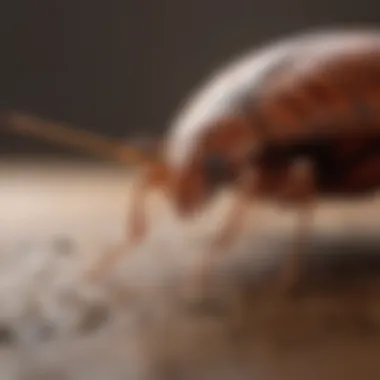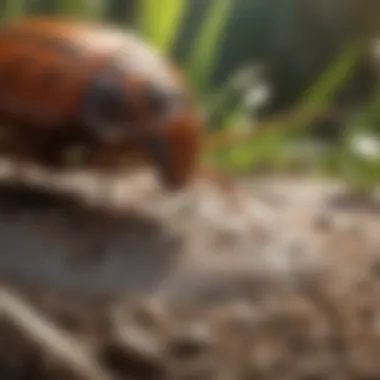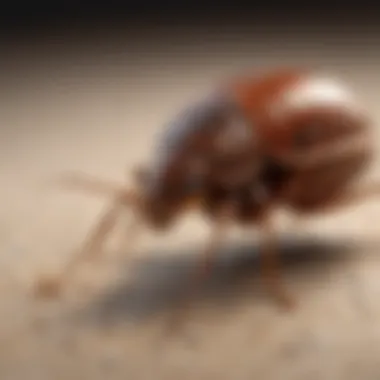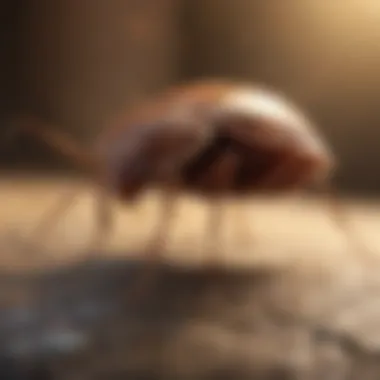Unveiling the Enigma of Bedbugs: An In-Depth Exploration


Unique Facts & Trivia
Unveiling little-known facts about bedbugs reveals their aversion to light, explaining their preference for nocturnal activities to avoid detection. Additionally, their ability to survive for extended periods without feeding showcases their remarkable resilience in adapting to diverse environments.
Surprisingly, bedbugs possess specialized mouthparts designed exclusively for piercing the skin of their hosts during feeding sessions. This adaptation speaks to their evolved feeding mechanisms developed over centuries of coexistence with humans.
Delving into the quirky behaviors of bedbugs unveils their tendency to aggregate in clusters, enhancing their chances of successful reproduction and survival amidst challenging conditions.
Introduction to Bedbugs
The section on 'Introduction to Bedbugs' is a pivotal aspect of this comprehensive guide. Understanding the behavior, habits, and implications of these elusive pests is crucial for anyone looking to safeguard their living spaces. This section sets the stage for the depth of information that follows, emphasizing the significance of early detection and proactive measures against infestations, subsequently leading to effective eradication strategies.
What Are Bedbugs?
Delving into the specifics of what bedbugs are reveals a world of minuscule yet formidable creatures that thrive in human habitats. Bedbugs, scientifically known as Cimex lectularius, are ectoparasites that exclusively feed on blood, posing a nuisance to both residential and commercial areas. These resilient insects are adept at concealing themselves in cracks and crevices, emerging at night to feed on unsuspecting hosts, causing discomfort and distress.
History of Bedbugs
Unraveling the historical background of bedbugs unveils a relentless legacy intertwined with human civilization. Bedbugs have plagued societies for centuries, with records tracing back to ancient Egypt and beyond. These resilient pests have adapted to diverse environments and eradication efforts, persisting as a challenging adversary throughout history. Understanding their evolution and historical impact provides valuable insights into combating their present-day resurgence.
Common Misconceptions
The realm of bedbug infestations is rife with misconceptions that cloud accurate perceptions and effective solutions. Contrary to popular belief, bedbugs are not limited to unkempt spaces but can infest any environment regardless of cleanliness. Dispelling myths surrounding bedbug behaviors and infestation patterns is essential in formulating informed prevention and eradication strategies, ensuring accurate responses to potential threats.
Ecological Importance
Despite their negative reputation, bedbugs play a notable role in the ecological balance of their habitats. As scavengers that recycle nutrients and maintain population control of certain species, bedbugs contribute to ecosystem dynamics in subtle yet significant ways. Understanding the ecological importance of bedbugs sheds light on their intricate relationships within the environment and the need for balanced coexistence mechanisms.


Bedbug Behavior and Characteristics
In this extensive guide on comprehending bedbugs, exploring their behavior and characteristics plays a pivotal role. Understanding the behavioral patterns and distinctive features of bedbugs is crucial in effectively managing infestations and implementing appropriate control measures. By delving into the intricacies of bedbug behavior, individuals can gain valuable insights into their habits, movement patterns, and tendencies. This section sheds light on the behavior and characteristics of bedbugs, providing readers with a comprehensive understanding of these elusive pests.
Feeding Habits
The feeding habits of bedbugs are a critical aspect to consider when addressing infestations. Bedbugs are hematophagous insects that feed exclusively on blood, preferring to feed on humans and other warm-blooded animals. Their feeding habits are primarily nocturnal, with peak activity during the night when their hosts are asleep. Bedbugs use piercing mouthparts to extract blood from their victims, leaving behind characteristic bite marks. Understanding their feeding habits is essential for early detection and effective treatment of infestations.
Reproduction Cycle
The reproduction cycle of bedbugs is a key factor contributing to the rapid proliferation of infestations. Bedbugs reproduce through a process known as traumatic insemination, where males pierce the abdomen of females to inseminate them. Females can lay hundreds of eggs during their lifetime, with optimal conditions leading to exponential population growth. By understanding the intricacies of the bedbug reproduction cycle, individuals can implement targeted strategies to disrupt their breeding cycle and prevent further infestations.
Preferred Habitats
Bedbugs have specific preferences when it comes to their habitats, favoring environments that offer easy access to their hosts and refuge for breeding. Common hiding spots for bedbugs include mattresses, box springs, crevices in furniture, and cracks in walls. By identifying the preferred habitats of bedbugs, individuals can conduct thorough inspections and implement preventive measures to minimize the risk of infestations. Understanding their habitat preferences is crucial for effectively targeting treatments and reducing the likelihood of recurrent infestations.
Identification and Detection
Identifying and detecting bedbugs in the early stages of an infestation is vital for prompt intervention and control. Bedbugs are adept at hiding in small cracks and crevices, making visual detection challenging. Common signs of a bedbug infestation include blood stains on bedding, dark fecal spots, shed skins, and a sweet musty odor. Utilizing detection tools such as mattress encasements, interceptors, and flashlight inspections can aid in identifying the presence of bedbugs. By familiarizing oneself with the signs of infestation and employing proactive detection methods, individuals can effectively manage bedbug issues before they escalate.
Signs of Bedbug Infestation
Signs of bedbug infestation play a crucial role in this comprehensive guide on bedbugs. Understanding the signs is fundamental to identifying and addressing bedbug issues promptly, safeguarding homes and ensuring peace of mind for residents. By delving into specific elements such as physical evidence, symptoms of bites, behavioral indicators, and visual clues, individuals can detect bedbugs early, preventing potential infestations from escalating unnoticed. This section sheds light on the significance of recognizing and responding to signs of bedbug presence swiftly.
Physical Evidence
Physical evidence of bedbugs is a key aspect in identifying infestations. It includes visible signs such as dark or rust-colored stains on sheets and mattresses, shed exoskeletons, and tiny eggshells. By closely examining areas where bedbugs tend to hide, such as seams and crevices of furniture, individuals can uncover these telltale signs. Detecting physical evidence helps confirm the presence of bedbugs, prompting timely action to mitigate the infestation's spread and impact on living spaces.


Symptoms of Bites
Symptoms of bites caused by bedbugs are important indicators of infestations. These bites often result in red, itchy welts on the skin, typically appearing in clusters or lines. Understanding the characteristics of bedbug bites, such as their delayed onset and resemblance to other insect bites, aids in differentiating them from other skin conditions. Recognizing these symptoms allows individuals to seek appropriate treatment and address the underlying bedbug infestation effectively.
Behavioral Indicators
Behavioral indicators offer valuable insights into the presence of bedbugs within a home or environment. Signs such as increased nocturnal activity, a distinctive musty odor, and the presence of fecal spots on bedding or upholstery suggest a bedbug infestation. Observing these behavioral clues enables early intervention to prevent further proliferation of bedbugs and mitigate potential harm to occupants' well-being.
Visual Clues
Visual clues serve as another essential aspect of identifying bedbug infestations. spotting live bedbugs, their eggs, or excrement in areas where they congregate, such as mattress seams, furniture joints, and wall crevices. Paying attention to these visual cues allows for accurate detection of bedbugs, facilitating targeted treatment measures to eliminate the infestation effectively. By recognizing and interpreting visual signs, individuals can address bedbug problems proactively, safeguarding their living environment.
Preventing Bedbug Infestations
In the comprehensive guide on understanding bedbugs, the section focusing on preventing bedbug infestations holds pivotal importance. Given the nuisance and potential health risks associated with bedbug infestations, implementing preventive measures is crucial to safeguarding living spaces. This segment not only sheds light on how to prevent bedbug invasions but also emphasizes the significance of early intervention to curb these resilient pests. By exploring various prevention tactics, readers can proactively defend against infestations, thereby fostering a secure and comfortable environment for residents.
Home Protection Strategies
When it comes to combating bedbug infestations, employing effective home protection strategies is paramount in maintaining a bedbug-free abode. These strategies encompass a range of proactive measures, such as regular cleaning routines, reducing clutter, and sealing entry points to prevent bedbugs from infiltrating living areas. Emphasizing the importance of proactive actions, this subsection delves into the tactical approaches that individuals can adopt to fortify their homes against potential bedbug threats, promoting a proactive and vigilant stance against infestations.
Travel Tips
As bedbugs are adept hitchhikers, travelers often face the risk of unknowingly bringing these pests back home. This subsection focuses on providing essential travel tips to mitigate the chances of encountering bedbugs during journeys. By offering practical advice on inspecting accommodations, luggage management, and post-travel precautions, readers can equip themselves with the requisite knowledge to prevent bedbug infestations stemming from travel experiences. Through a thorough exploration of travel-related scenarios, this segment serves as a comprehensive resource for travelers seeking to avoid unwelcome bedbug encounters.
Second-Hand Items Precautions
Acquiring second-hand items can unwittingly introduce bedbugs into homes, posing a significant threat to dwellings. This section delves into the precautions necessary when procuring pre-owned furniture, clothing, or other items to prevent potential bedbug infestations. By outlining detailed steps such as inspecting items, washing and treating goods, and quarantine procedures, readers can navigate the realm of second-hand acquisitions with vigilance and awareness, thwarting bedbug intrusions effectively.


Routine Inspections
To maintain vigilance against bedbug infestations, routine inspections play a vital role in early detection and intervention. This subsection underscores the importance of regular checks for signs of bedbugs, emphasizing the significance of prompt action upon detection. By guiding readers through the process of conducting thorough inspections, including key areas to examine and common indicators of infestations, this segment equips individuals with the knowledge and skills necessary to proactively address potential bedbug threats, ensuring a pest-free living environment.
Getting Rid of Bedbugs
In the realm of bedbug management, the process of eradicating these stubborn pests plays a pivotal role. Getting rid of bedbugs is a crucial aspect of maintaining a healthy living environment and preventing the potential spread of infestations. This article aims to shed light on the significance of effectively eliminating bedbugs, providing readers with a comprehensive understanding of the various methods and strategies available for combating these nocturnal nuisances.
Professional Extermination
When faced with a severe bedbug infestation that surpasses DIY remedies, the option of professional extermination emerges as a viable solution. Professional extermination services offer a level of expertise and precision that may be challenging to achieve independently. Pest control professionals employ advanced techniques and products to eradicate bedbugs efficiently, ensuring thorough elimination and preventing recurrence. From thorough inspections to tailored treatment plans, professional exterminators bring a wealth of knowledge and experience to the table, delivering effective results for households plagued by persistent bedbug issues.
DIY Remedies
For individuals preferring a hands-on approach to bedbug control, do-it-yourself remedies present cost-effective alternatives to professional services. DIY options range from natural remedies like essential oils and diatomaceous earth to mechanical solutions such as bedbug mattress encasements and traps. By leveraging homemade sprays, vacuuming techniques, and diligent clutter removal, homeowners can supplement professional treatments and enhance the overall effectiveness of their bedbug eradication efforts. While DIY remedies require dedication and consistency, they empower individuals to take proactive measures in eliminating bedbugs and safeguarding their living spaces.
Persistent Infestation Solutions
In cases of persistent bedbug infestations resistant to initial treatment methods, the pursuit of specialized solutions becomes imperative. Persistent infestation scenarios demand a comprehensive approach that combines multiple strategies to address resilient bedbug populations. This may involve repeated professional extermination services, heat treatments, or the use of insecticide formulations tailored for stubborn infestations. Targeting hard-to-reach areas and focusing on long-term prevention measures are essential components of combating persistent bedbug challenges effectively. By implementing a persistent infestation strategy, individuals can increase their chances of achieving sustained relief from recurrent bedbug issues.
Post-Treatment Prevention
Following successful bedbug extermination, the focus shifts to post-treatment prevention measures aimed at avoiding future infestations. Post-treatment prevention involves adopting proactive habits, such as regular inspections, maintaining cleanliness, and minimizing clutter to deter bedbug reinfestation. Additionally, sealing potential entry points, such as cracks and crevices, and incorporating protective measures like bedbug-proof encasements contribute to a fortified defense against bedbug resurgence. By implementing meticulous post-treatment prevention strategies, individuals can prolong the efficacy of their eradication efforts and promote a bedbug-free living environment.
Conclusion
Concluding the gripping journey through the world of bedbugs, this final section encapsulates the essence of vigilance and knowledge in dealing with these elusive pests. While many may underestimate the impact of a bedbug infestation, the realities of these tiny troublemakers can be daunting. In this guide, we unravel the intricacies of bedbug behavior, habitats, detection, prevention, and eradication methods, empowering readers with vital insights to protect their living spaces and well-being.
Understanding the importance of awareness and proactive measures is crucial in safeguarding against the stealthy advances of bedbugs. By familiarizing yourself with the signs of infestation, implementing preventative strategies, and knowing how to address an existing problem effectively, you are not only defending your property but also ensuring peace of mind and comfort in your surroundings.
Emphasizing the significance of routine inspections and diligence in maintaining a pest-free environment, this guide serves as a beacon of knowledge for homeowners, renters, or anyone intrigued by the world of parasites. Awareness is the first line of defense against these resilient insects, and by being equipped with the information provided here, readers are better prepared to tackle any potential bedbug challenges that may arise.
Steering away from the usual misconceptions and trivial facts, this section encapsulates the practical wisdom needed to navigate the complexities of bedbug control. From deciphering symptoms to choosing between professional extermination and DIY remedies, the insights offered herein aim to equip readers with a holistic approach to combating these pests effectively.
In essence, the Conclusion section ties together the threads of information woven throughout this comprehensive guide, serving as a beacon of knowledge in the battle against bedbugs. By instilling awareness, offering strategic prevention tips, and advocating for a proactive stance, this guide stands as a valuable resource for anyone seeking to safeguard their living spaces from the clandestine threats of these minuscule nuisances.







